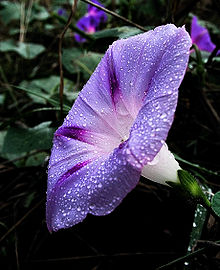- Ipomoea purpurea
-
Ipomoea purpurea 
Scientific classification Kingdom: Plantae (unranked): Angiosperms (unranked): Eudicots (unranked): Asterids Order: Solanales Family: Convolvulaceae Genus: Ipomoea Species: I. purpurea Binomial name Ipomoea purpurea
(L.) Roth[1]Ipomoea purpurea, the Purple, Tall, or Common Morning Glory, is a species in the genus Ipomoea, native to Mexico and Central America. Like all morning glories the plant entwines itself around structures, growing to a height of 2–3 m tall. The leaves are heart-shaped and the stems are covered with brown hairs. The flowers are trumpet-shaped, predominantly blue to purple or white, 3–6 cm diameter. [2]
Contents
Habitats
The plant is predisposed to moist and rich soil, but can be found growing in a wide array of soil types.[3] It is naturalized throughout warm temperate and subtropical regions of the world. Although it is often considered a noxious weed, Ipomoea purpurea is also grown for its beautiful purple and white flowers and has many cultivars. Common cultivars include I. purpurea 'Crimson Rambler' (red-violet blossoms with white throats); 'Grandpa Ott's,' 'Kniola's Black Knight,' and 'Star of Yelta' (blossoms in varying shades of deep purple with white or pale pink throats); and 'Milky Way' (white blossoms with mauve accents).
The triangular seeds have some history of use as a psychedelic; they, like Ipomoea tricolor contain LSA.[3] Effects are reported to be somewhat similar to those of LSD.[4]
Gallery
-
Ipomoea purpurea in Loganville, Georgia
See also
Notes
- ^ USDA Plants Profile
- ^ Germplasm Resources Information Network: Ipomoea purpurea
- ^ a b Richard H. Uva, Joseph C. Neal and Joseph M. Ditomaso, Weeds of The Northeast, (Ithaca, NY: Cornell University Press, 1997), Pp. 214-217
- ^ Charles Savage, Willis W. Harman and James Fadiman, Ipomoea purpurea: A Naturally Occurring Psychedelic
External links
Categories:- Ipomoea
- Flora of Central America
- Flora of Mexico
- Garden plants of Central America
- Medicinal plants
- Invasive plant species in South Africa
Wikimedia Foundation. 2010.








